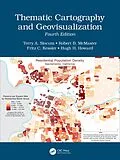This comprehensive and well-established cartography textbook covers the theory and the practical applications of map design and the appropriate use of map elements. It explains the basic methods for visualizing and analyzing spatial data and introduces the latest cutting-edge data visualization techniques. The fourth edition responds to the extensive developments in cartography and GIS in the last decade, including the continued evolution of the Internet and Web 2.0; the need to analyze and visualize large data sets (commonly referred to as Big Data); the changes in computer hardware (e.g., the evolution of hardware for virtual environments and augmented reality); and novel applications of technology.
Key Features of the Fourth Edition:
- Includes more than 400 color illustrations and it is available in both print and eBook formats.
- A new chapter on Geovisual Analytics and individual chapters have now been dedicated to Map Elements, Typography, Proportional Symbol Mapping, Dot Mapping, Cartograms, and Flow Mapping.
- Extensive revisions have been made to the chapters on Principles of Color, Dasymetric Mapping, Visualizing Terrain, Map Animation, Visualizing Uncertainty, and Virtual Environments/Augmented Reality.
- All chapters include Learning Objectives and Study Questions.
- Provides more than 250 web links to online content, over 730 references to scholarly materials, and additional 540 references available for Further Reading.
There is ample material for either a one or two-semester course in thematic cartography and geovisualization. This textbook provides undergraduate and graduate students in geoscience, geography, and environmental sciences with the most valuable up-to-date learning resource available in the cartographic field. It is a great resource for professionals and experts using GIS and Cartography and for organizations and policy makers involved in mapping projects.
Autorentext
Terry Slocum is Professor Emeritus Associate Professor at the Department of Geography and Atmospheric Science, College of Liberal Arts and Sciences, University of Kansas, USA. In 1998 he received Teacher Appreciation Award by the Center for Teaching Excellence (CTE), University of Kansas. Robert B. McMaster is a Professor in the Geography Department at the University of Minnesota since 1990. He has been President of the Cartography and Geographic Information Society (CaGIS), and currently is serving on the Board of the UCGIS and is a Vice President of the International Cartographic Association. Fritz Kessler, is a senior research associate and an Associate Professor at Penn State University. He is CRC Press author. He is a member of the International Cartographic Association Commission on Map Projections, vice president of the North American Cartographic and Information Society, and a board member of the Cartography and Geographic Information Society. He was a former editor in chief of Cartographic Perspectives. Hugh H. Howard is a Professor in the Department of Science & Engineering at the American River College, California.
Klappentext
Given the extensive developments that have taken place in cartography and GIS in the last decade, the fourth edition of a well-established book in cartography explores the continued evolution of the Internet and Web 2.0. A new chapter on Geovisual Analytics captures the analysis and visualization of Big Data, while a new chapter on Cartography, Technology, and Society reviews the critical and ethical issues involved with collecting, using, and storing digital data; the importance of participatory cartography; and web-based geospatial data sources. Thoroughly revised, this book equips educators and benefit students with the most valuable up-to-date learning resource available in the cartographic field. Short Blurb The fourth edition of a well-established book in cartography explores the continued evolution of the Internet and Web 2.0 and captures the analysis and visualization of Big Data. Thoroughly revised, this textbook equips educators and benefit students with the most valuable up-to-date learning resource available in the cartographic field.
Inhalt
Chapter 1. Introduction, Chapter 2. A Historical Perspective on Thematic Cartography, Chapter 3. Statistical and Graphical Foundation, Chapter 4. Principles of Symbolization, Chapter 5. Data Classification, Chapter 6. Scale and Generalization, Chapter 7. The Earth and Its Coordinate System, Chapter 8. Elements of Map Projections, Chapter 9. Selecting an Appropriate Map Projection, Chapter 10. Principles of Color, Chapter 11. Map Elements, Chapter 12. Typography, Chapter 13. Cartographic Design, Chapter 14. Map Reproduction, Chapter 15. Choropleth Mapping, Chapter 16. Dasymetric Mapping, Chapter 17. Isarithmic Mapping, Chapter 18. Proportional Symbol Mapping, Chapter 19. Dot Mapping, Chapter 20. Cartograms, Chapter 21. Flow Mapping, Chapter 22. Multivariate Mapping, Chapter 23. Visualizing Terrain, Chapter 24. Map Animation, Chapter 25. Data Exploration, Chapter 26. Geovisual Analytics, Chapter 27. Visualizing Uncertainty,Chapter 28. Virtual Environments and Augmented Reality
